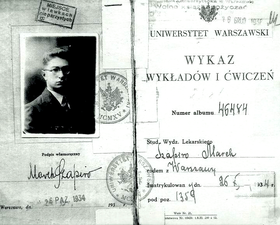
Back Bancs del gueto Catalan Benka Geto Esperanto Bancs ghetto French ספסלי גטו HE Getto ławkowe Polish Гетто за партами Russian Лавкове гетто Ukrainian
| Ghetto benches | |
|---|---|
 The 1934 Index of a Polish-Jewish student at the Warsaw University Department of Medicine, with a stamp reading: Miejsce w ławkach nieparzystych (Seating in benches with an odd number) | |
| Location | Warsaw University, Lwów Polytechnic, Wilno University |
| Period | 1935–1939 |
| Part of a series on |
| Discrimination |
|---|
 |
Ghetto benches (known in Polish as getto ławkowe)[1][2] was a form of official segregation in the seating of university students, introduced in 1935 at the Lwów Polytechnic.[3] Rectors at other higher education institutions in the Second Polish Republic had adopted this form of segregation when the practice became conditionally legalized by 1937.[4] Under the ghetto ławkowe system, Jewish university students were required under threat of expulsion to sit in a left-hand side section of the lecture halls reserved exclusively for them. This official policy of enforced segregation was often accompanied by acts of violence directed against Jewish students by members of the ONR (outlawed after three months in 1934).
The seating in benches marked a peak of antisemitism in Poland between the world wars according to Jerzy Jan Lerski.[5] It antagonized not only Jews, but also many Poles.[5] Jewish students protested these policies, along with some Poles who supported them by standing instead of sitting.[6] The segregation continued until the invasion of Poland in World War II. Poland's occupation by Nazi Germany suppressed the entire Polish educational system. In the eastern half of Poland annexed by the Soviet Union, such discriminatory policies in education were lifted.[7]
- ^ Cite error: The named reference
adlwas invoked but never defined (see the help page). - ^ Cite error: The named reference
netfirmswas invoked but never defined (see the help page). - ^ Cite error: The named reference
Antisemitism and Its Opponents in Modern Polandwas invoked but never defined (see the help page). - ^ Cite error: The named reference
maxveritaswas invoked but never defined (see the help page). - ^ a b Cite error: The named reference
HDwas invoked but never defined (see the help page). - ^ Cite error: The named reference
Diaghwas invoked but never defined (see the help page). - ^ Tomasz Kamusella, Krzysztof Jaskułowski (2009). Nationalisms Today. Peter Lang AG, International Academic Publishers. p. 203. ISBN 9783039118830.